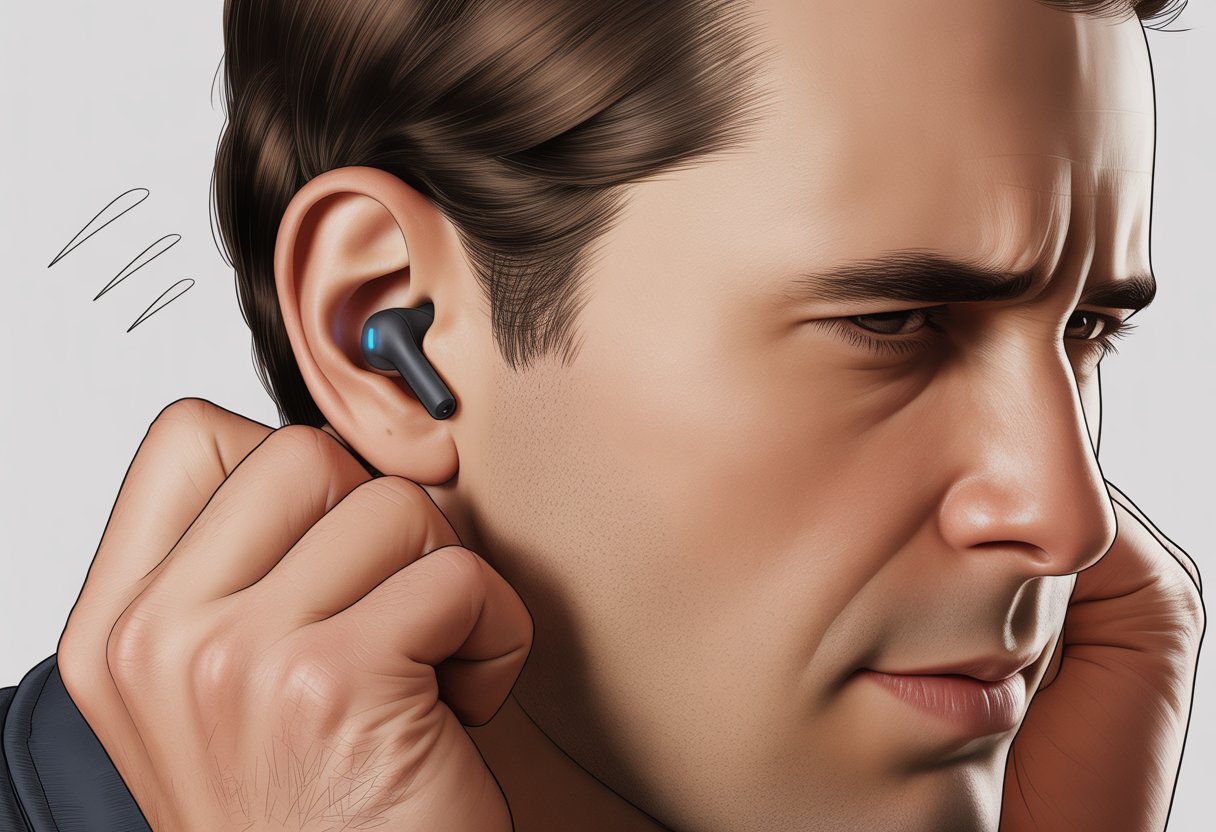Let’s be real—nothing kills a good playlist faster than Bluetooth headphones that just refuse to stay put. We’ve all experienced it: walking, jogging, or even just sitting still, and suddenly one earbud pops out like it’s got better places to be.
It’s awkward, right? You do that weird dance, trying to shove the earbud back in while acting like nothing’s wrong.

Bluetooth headphones usually fall out because our ear shape doesn’t match the one-size-fits-all design, or the tips just aren’t the right size or material for us. Sweat, movement, and even a little extra earwax can turn a peaceful playlist into a slapstick routine.
Luckily, there are a bunch of reasons—and some clever fixes—so we’re not stuck forever chasing earbuds down the street.
We’re going to look at why earbuds keep making escape attempts, and share some of the easiest ways to keep them in place. It’s finally time to stop the slip and just enjoy your music—because our ears deserve a break.
Why Bluetooth Headphones Fall Out
Honestly, it’s kind of embarrassing when an in-ear headphone launches itself across the room mid-jog. Staying connected to both our Bluetooth device and our own ears? Apparently, that’s harder than it sounds.
Ear Canal Shapes And Sizing
Let’s get real: our ears are like fingerprints—no two ear canals match. The shape, slope, and size of our ear canal all change how headphones fit.
If earbuds are too big, they barely squeeze in. Too small, and they rattle around with every step.
Some of us have oval ear canals, others round, and a few twist in ways that headphone designers probably never imagined. “One size fits all” rarely works.
People share endless tips and stories about earbuds that just won’t stay put, especially since most Bluetooth headphones only come with a couple of rubber tip sizes.
Here’s a random ear fact: our ear canal size can change with age or even from one side to the other. That left headphone might feel perfect, but the right one drops out every single time.
Here are more tips on keeping earbuds from falling out.
Improper Fit Of In-Ear Headphones
Sometimes, the headphones themselves deserve the blame. Many Bluetooth in-ear models just don’t fit well straight from the box.
If we pick the wrong tip size, or the seal isn’t tight, the headphones basically become escape artists.
The earbud often sits right at the edge of our ear canal, just waiting to jump ship. Even “fancy” models with multiple tip sizes might not suit our unique ear shape.
Some designs focus on being tiny or lightweight, but that can mean less grip. Foam tips or winged attachments help, but if the fit is still off, we’re left juggling headphones instead of enjoying music.
Movement And Activity Challenges
Just when we think we’ve got them settled, we move. We walk, nod, run, or even yawn, and the headphones make a break for freedom.
Physical activity makes gravity and friction team up against us. The more we sweat, the easier it is for in-ear headphones to slip.
Even a small bounce can send the headphones tumbling if the fit isn’t secure. Gym sessions? Sometimes they turn into a never-ending game of “catch the runaway earbud.”
Some people add hooks or straps for more security, but not everyone wants to look like they’re prepping for a moon landing.
Wireless designs add convenience, but they also introduce more ways for in-ear headphones to annoy us by popping out at the worst times.
Design Flaws And Headphone Features
Sometimes, Bluetooth headphones just don’t want to be friends with our ears. Tiny design details—like weight distribution or the choice of materials—can turn in-ear magic into a never-ending game of pick-up from the floor.
Weight And Balance Issues
Let’s be honest—we’re not here for a heavy workout lifting headphones off the sidewalk every few minutes. The weight of some Bluetooth headphones, especially those loaded with extra features like noise cancelling or big batteries, makes them a bit too “gravity friendly.”
This extra heft throws off the balance, making the buds slip, tilt, or straight-up plummet out of our ears whenever we sneeze or nod to the beat.
Manufacturers keep cramming more tech into tiny earpieces, but our ears never signed up for these mobile dumbbells. In-ear headphones with a bulky body or uneven weight sit awkwardly and press down in weird ways.
If most of the weight is at the back, the front starts to wiggle loose, and vice versa. Some headphones even have long stems that look cool but act like little levers, slowly prying themselves free the moment we move.
Who needs arm day at the gym when we’ve got arm day chasing earbuds?
Ear Tip Materials
We all have different ears, but headphone makers keep pretending “one tip fits all.” The ear tip material plays a sneaky but major part in whether they stay put or pop out every time we smile or talk.
Silicone tips are smooth, but they get slippery when we sweat, turning noise cancelling earbuds into noise welcoming projectiles.
Foam ear tips give a tighter, more custom fit because they expand to fill the ear canal. But even foam gets squished down too quickly, losing grip as we listen to music or call grandma for the third time.
Sometimes, the sound quality takes a hit if the seal isn’t perfect, leaving us with thin bass and flat sound.
Some brands now experiment with different shapes and hybrid materials. Large or oddly shaped tips can hurt or put pressure on the wrong spots, making us wish for custom-molded comfort usually reserved for rock stars.
If only buying replacement tips for our headphones was as fun as picking out a new pair of shoes.
Common Human Errors (Yes, We All Do Them)
Sometimes, it’s not the Bluetooth headphones to blame—it’s us. Tiny mistakes like using the wrong ear tip or shoving the buds in sideways can make those pricey headphones pop right out.
Wrong Ear Tip Size
Let’s be honest. Most of us grab the medium ear tips and move on. But ear canals come in all shapes, and “medium” isn’t a magical fit-all setting.
If tips are too small, headphones will wiggle out the moment we yawn. Too large, and suddenly our ears feel like they’re being punished for existing.
The fix? Experiment! Most Bluetooth headphones come with at least three tip sizes. Try each one until the fit feels snug and comfortable.
Once in, give your head a little shake. Do the headphones stay put? If so, you’ve found a winner.
For folks with charging cases, make sure the tips you pick still fit inside the case, or you might not be able to close it—or worse, charge your headphones.
Inserting Headphones Incorrectly
We’ve all done it: running late, jamming headphones in, and… they pop right out as soon as we move. There’s actually a right way to insert most in-ear Bluetooth headphones.
Usually, the tip should point slightly forward and up as it goes in, matching the shape of our ear canal.
Steps to insert properly:
- Twist slightly as you insert; don’t just shove.
- Make sure the bud is snug inside the canal, not barely hanging on the edge.
- If your headphones have a wing or hook—use it!
A quick look at the owner’s manual (or a fast Google search) can show the proper technique. If our headphones have left and right markings, double-check them.
Mixing them up almost guarantees a quick escape, possibly into the waiting jaws of a couch cushion. If we use a different Bluetooth device or change devices, sometimes the angle or fit shifts, so double-check each time for a secure fit.
Technological Troubles That Make Things Worse
Bluetooth headphones find new ways to mess with us. Besides slipping out, we also get to fight with connection problems and the classic “silent treatment” from one side of our headphones.
Connectivity Issues With Bluetooth Devices
We all expect our Bluetooth headphones to connect like magic, but sometimes we end up shaking our heads more than actually bobbing to the music. Frequent connection drops happen, especially around laptops that just can’t commit.
Our headphones might pair with our computer, phone, or even our neighbor’s fridge before they finally decide to work with us.
Common headaches:
- Headphones not connecting at all
- Random disconnects
- One side not syncing
Interference from other wireless devices, too many paired gadgets, or outdated drivers can make things even messier. If we’re switching between devices, let’s not be surprised if our headphones act confused and mute themselves just to keep us guessing.
For more tips on these Bluetooth headphone problems, Wired breaks down the most annoying issues and how to deal with them.
No Audio In One Ear: Slippery Slope
Is there anything more confusing than when only one earbud works and the other just gives up? Sometimes, we’ve been a bit too generous with earwax, creating a slippery, waxy slide that makes the earpiece misbehave or not seal well.
If the fit is loose or wax builds up, sound in one earbud may fade or dip out entirely. Sweat, dirt, or the weird shape of our ear canal can also cause issues.
Even laptops and computers sometimes send audio to one earbud if Bluetooth settings are off or if the headset was dropped on the ground (probably while we were chasing it).
More about how wax and fit issues can cause audio problems is on this Reddit thread. If there’s no audio in one ear, try cleaning the buds, check the audio balance settings, or just accept that your headphones are pranking you—again.
Environmental And Lifestyle Factors
Let’s admit it, sometimes our headphones have a mind of their own, especially when our daily habits add a few plot twists. Sweat, weather, and even the way we treat our gear can turn a snug fit into a frustrating juggling act.
Sweat And Moisture
If you’re channeling your inner athlete—or just sweating it out on a hot day—moisture definitely plays a part in the great earbud escape. Sweat makes ear tips slippery, so headphones slide out when you move, jump, or even just nod along to a song.
All that moisture doesn’t just disappear over time. It can mess with earbud materials too. Silicone tips might get a bit gummy, and foam tips soak up sweat and lose their shape. When headphones aren’t water-resistant, sweat can damage the sensitive parts, even the charging case.
Tossing wet earbuds right into the case? That’s a recipe for a funky smell or connection issues.
To fight sweat’s evil plans:
- Use sport-specific or water-resistant earbuds.
- Wipe the ear tips and your ears before using them.
- Let everything dry before popping the buds in the charging case.
Daily Wear And Tear
Let’s be real—we’re not always gentle with our gear. Tossing headphones into a bag or letting them rattle around in our pockets means dirt, lint, and the occasional mystery crumb are just waiting to attack.
Ear tips can get stretched out or torn, which makes it tough for them to stay put. Repeatedly yanking on the cord (for wired ones), dropping the charging case, or just using them a lot can break or loosen small parts.
Even the best headphones eventually wear out if we treat them like superhero gadgets. Keeping the charging case and ear tips clean helps a lot—just check for damage every now and then.
If things still get wobbly, swapping the tips or case is a quick fix. No need to buy a whole new set. If your Bluetooth headphones are still unreliable, there could be other environmental factors interfering with connectivity.
Solutions To Keep Your Headphones In Place
Trying to keep in-ear headphones from falling out can feel like a daily struggle. With the right ear tips, some smart accessories, and a few clever tricks, you can keep your music playing and your earbuds where they belong.
Choosing The Right Ear Tips
Let’s be honest—our ear canals don’t come in a standard size. If the ear tips are too loose or too big, those earbuds slip out like soap in the shower.
Trying different sizes and materials is the first step. Most headphones come with a few options in the box, so don’t just leave them under the couch.
Silicone ear tips are everywhere, but honestly, some people find memory foam grips better—especially when your ear canals seem to randomly expand while you’re chewing or laughing.
If you’re still struggling, you can buy third-party tips in all sorts of shapes and sizes. Finding a snug fit helps keep headphones in place and blocks out noise for better sound.
It might take a little trial and error (and maybe a few eyerolls), but you’ll notice a big difference when your ear tips actually match your ear canals. The sweet spot is when the tip sits just inside the canal without feeling uncomfortable.
Using Accessories For Extra Grip
Sometimes headphones just need a little help. Accessories like earbud wings, or stability fins, give extra grip by adding more surface area that rests inside or just outside your ears.
Some brands include these wings, but you can always order extras if you’re curious. If you sweat a lot while exercising, a light sweatband keeps ears dry and helps stop headphones from sliding out.
And if you want to go full MacGyver, wrapping a bit of medical tape around the stem of each earbud actually gives surprising grip.
It’s not cheating; it’s just smart.
Trying Over-Ear Hooks Or Bands
When ear tips and accessories aren’t enough, try headphones with over-ear hooks or bands. These wrap around the tops or backs of your ears, giving an extra anchor so the headphones aren’t just clinging for dear life.
This design is especially helpful if you’re active or your ears seem to reject every normal earbud. Most over-ear hooks are soft and flexible, so they’re comfortable even during long workouts.
Headbands and straps that connect earbuds and rest behind your head add another point of stability. With this setup, even jumping jacks aren’t a headphone rescue mission anymore.
Next time you’re considering glue or duct tape (please, don’t), remember there are options designed for exactly this problem. For more ideas and tips, check out this guide on how to keep earbuds from falling out.
When To Service Your Product Or Seek Help
Sometimes, no matter how much we wiggle, twist, or even pray, our Bluetooth headphones just won’t stay put.
If you spend more time jamming them back in than actually listening, maybe it’s time to call for backup.
Here are a few warning signs that you might need help:
- Physical damage: Are your buds cracked, bent, or missing pieces? Time for a repair.
- Loose fit: If swapping ear tips or trying every trick still doesn’t keep them in place, that’s a red flag.
- Charging case issues: When the case won’t snap shut, refuses to charge, or just blinks at you like it’s taunting you, it needs some attention.
- Bluetooth drama: If your headphones keep disconnecting or flat-out refuse to pair—even after multiple restarts—you might need professional help. Sometimes, there’s a deeper issue with the Bluetooth device or headphones themselves.
Most brands make it pretty easy to schedule service with the manufacturer. You can usually find online forms to request help for busted buds or flaky cases.
If you’re still under warranty, that’s a win! You might get a free fix or even a replacement.
Hang on to those receipts and warranty cards, just in case the repair shop asks for proof.
When you’re not sure what to do, just call support. Honestly, they’ve probably seen weirder headphone disasters than whatever you’re dealing with.
- Why is my fitness tracker not pairing with Apple Health? Troubleshooting for Technologically Cursed Mortals - December 22, 2025
- Why is my fitness tracker not updating firmware? Tech Tantrums and Update Woes Explained - December 21, 2025
- Why is the Sound Quality on My Bluetooth Headphones Poor? It’s Not Just Bad Music Taste! - December 21, 2025






